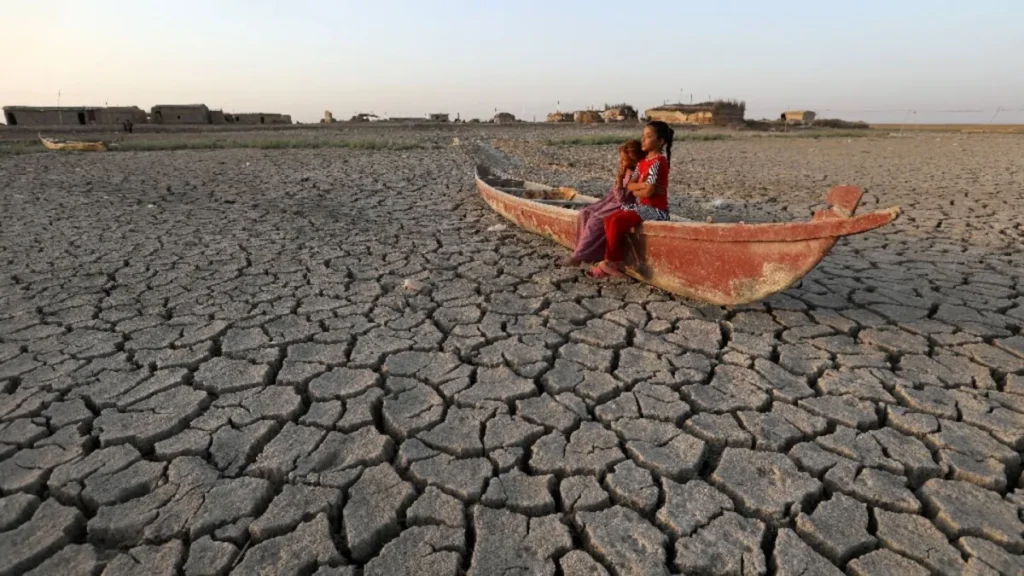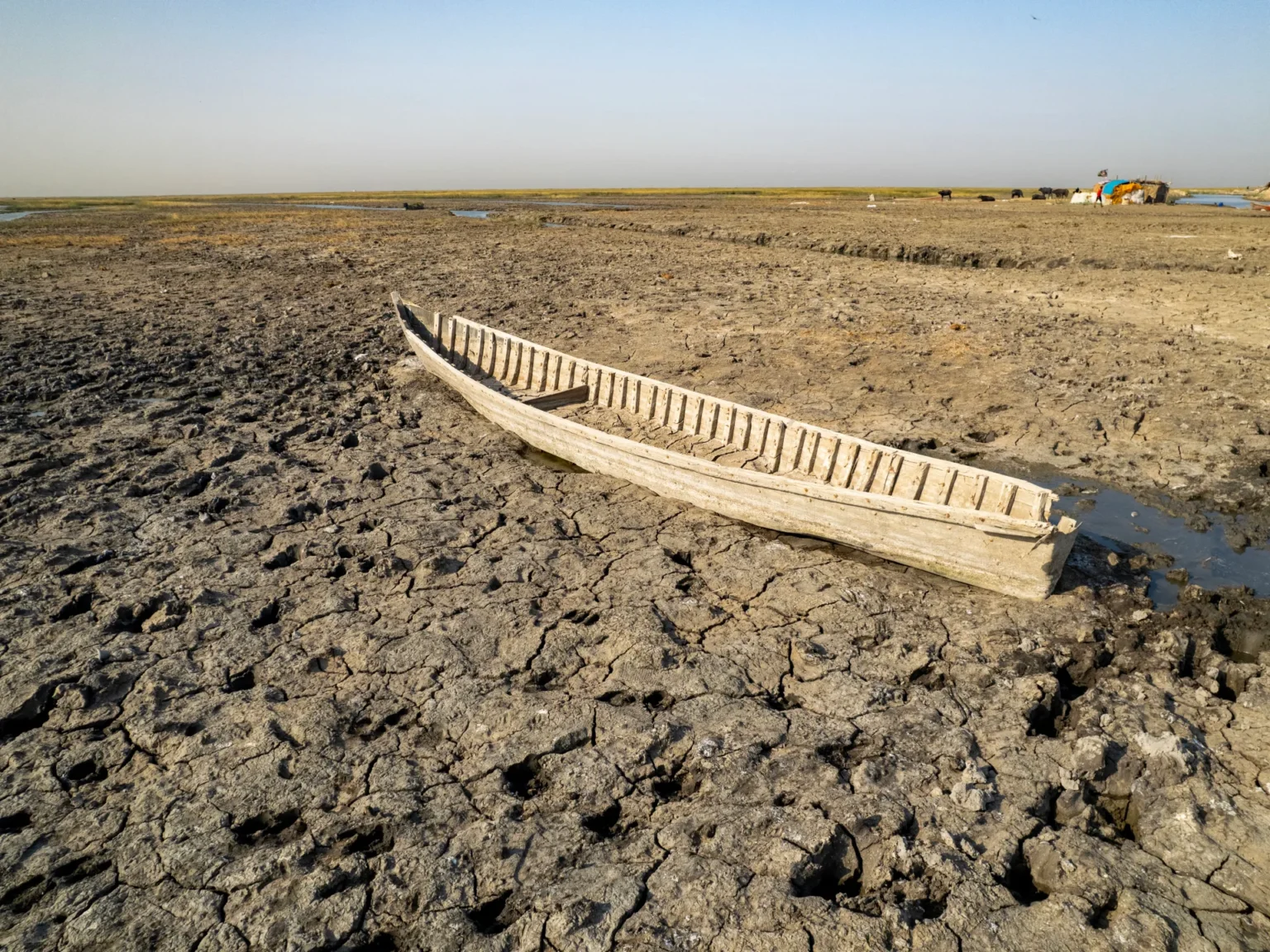Iraq worst drought century is currently devastating the country, reducing water levels in the Tigris and Euphrates rivers and threatening millions of people. Experts warn that immediate action is critical to prevent a humanitarian and environmental disaster. The situation is unprecedented in the last 100 years, with water shortages, crop failures, and declining livestock posing severe risks to communities across the country.
The Scale of the Crisis
According to reports from Al Jazeera, the flow of Iraq’s two major rivers, the Tigris and Euphrates, has decreased by approximately 27% due to low rainfall and upstream water impoundment. These rivers, which have sustained civilizations for millennia, are now reduced to mere trickles in some areas. In the southern part of the country, particularly in Basra, a humanitarian crisis caused by drought and water shortages is unfolding. The quality of seawater, already unsuitable for human consumption, has been further degraded by oil spills, agricultural runoff, and sewage discharge. Saltwater traveling from the Gulf via the Shatt Al-Arab River has been moving steadily upriver, increasing salinity levels in the Basra region. The flow of freshwater is diminishing due to dams upstream.
The Mihayla desalination station in Abul Khaseeb district has been operating to alleviate Basra’s water crisis for more than a year. It uses a special method to treat water containing high quantities of salt from the Shatt Al-Arab River. “We produce nearly 72,000 cubic meters [19 million gallons] of treated water daily, currently serving about 50 percent of Abul Khaseeb district,” said Sa’dun Abbud, senior engineer at the Mihayla Water Desalination Station. “Salinity in the Shatt Al-Arab River has reached nearly 40,000 total dissolved solids. After desalination, the refuse is returned to the river.”
Experts warn that the water crisis will worsen unless there is urgent government action. “Basra has lost 26 to 30 diverse marine species due to saltwater intrusion,” said Alaa Al-Badrani, a water expert. “This has created a new, hybrid environment unsuitable for both freshwater and seawater species. With salinity levels rising, the water is also unfit for agriculture.”
While reduced rainfall and rising temperatures are global challenges, Iraq’s water crisis is also the result of upstream restrictions and domestic neglect. “Corruption and self-interest among Iraq’s political elite weaken institutional capacity,” wrote Hayder Al-Shakeri, research fellow in the Middle East and North Africa programme at Chatham House. “This creates opportunities for its neighbors Turkey and Iran to push for deals that don’t necessarily benefit Iraq,” he added.
Agricultural Devastation
The drought has wreaked havoc on Iraq’s agricultural sector, once the backbone of its economy. Farmers in regions like Dhi Qar have seen their crops wither and livestock perish due to the lack of water. The buffalo population, essential for dairy production, has plummeted from 150,000 in 2015 to fewer than 65,000, according to Reuters. Farmers like Sabah Ismail have been forced to sell or have lost large portions of their herds—dropping from over 120 buffalo to as few as 50 due to limited pasture, rising fodder prices, and poor water conditions.
This decline in livestock and crop yields is pushing rural farmers to abandon their lands for urban areas, threatening centuries-old agricultural traditions in the Fertile Crescent.

Environmental and Health Impacts
The environmental consequences of the drought are equally alarming. In the southern marshlands, once lush ecosystems are now barren. The Najaf Sea, a vital water reservoir and habitat for birds and fish, is experiencing near-total drought, sparking alarm among environmental experts and residents in Holy Najaf province. Once a vital water reservoir and habitat for birds and fish, the Najaf Sea also served as a stopover for migratory birds between Asia and Africa.
The lack of water has also led to the degradation of soil quality, making it increasingly difficult for farmers to cultivate crops. The combination of water scarcity and soil degradation is transforming Iraq’s semi-arid environment into a desert. Rising temperatures, decreasing rainfall, and severe droughts are exacerbating this transformation, turning Iraq into one of the countries most vulnerable to the effects of climate change.
Urgent Need for Action
The situation demands immediate and coordinated action from both the Iraqi government and the international community. Experts emphasize the need for comprehensive water management strategies, investment in water infrastructure, and regional cooperation to address the upstream restrictions that exacerbate the crisis.
International organizations like UNICEF have warned that over 2 million children and their families will face significant lack of water by 2030 if no action is taken now. The United Nations has also highlighted the urgency of the situation, calling for immediate measures to mitigate the impact of the drought and ensure sustainable water resources for future generations.
Without swift and decisive action, Iraq risks facing a prolonged water crisis that could have devastating effects on its population, economy, and environment. The time to act is now.
Do follow on: Instagram
Read More: Bahraini Artist Reimagines ‘The Simpsons’ with Khaleeji Flair



